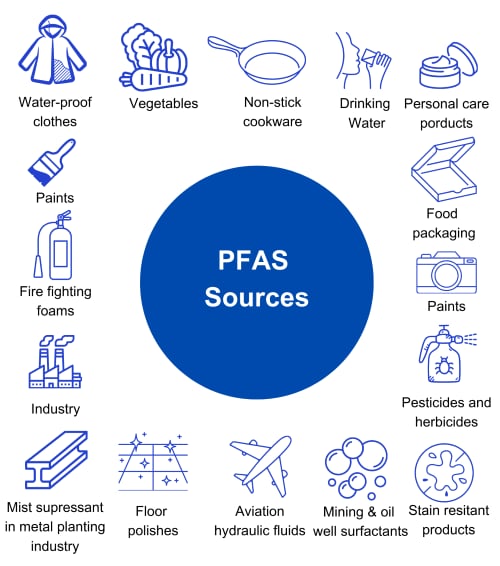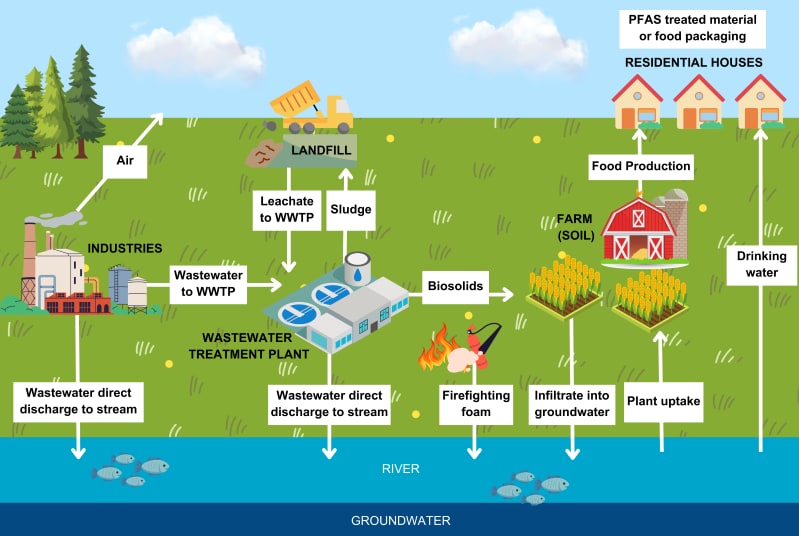SUIKI was carved out from TDK and became an independent company, PFASuiki. You can find their official website here.
Developing Technologies
March 2025
SUIKI’s Groundbreaking Prototype:
Revolutionizing PFAS Destruction
PFAS, known as “forever chemicals,” pose significant environmental and health challenges
due to their persistence in ecosystems and resistance to conventional treatment methods.
At SUIKI, we are pioneering the development of innovative solutions to address these
challenges, starting with our prototype, Aquahive.
This article highlights the urgent need for PFAS destruction, the advantages of
electrochemical oxidation (ECO), and the promising capabilities of our prototype.
ON THIS PAGE
What Are PFAS and Why Are They a Concern?
What are PFAS?
PFAS (per- and polyfluoroalkyl substances) are a group of synthetic chemicals that have been utilized in various industries and consumer products since the 1940s due to their unique properties. There are thousands of different PFAS, with some being more extensively used and studied than others. These chemicals are found in everyday items such as fast-food packaging, non-stick cookware, waterproof clothing, makeup, and many other products.
Why Are We Hearing About PFAS Now?
Recent advancements in testing technology have revealed the widespread presence of PFAS in trace amounts across the globe. These substances are now detectable in water, air, soil, and even in animals, highlighting their pervasive nature.
Are PFAS Harmful?
Exposure to high levels of PFAS can lead to adverse health effects. Ongoing studies are investigating whether low-level exposure over time also poses health risks. PFAS are often referred to as "forever chemicals" because of their remarkable persistence in the environment. Their chemical properties prevent them from breaking down easily, leading to their accumulation in water, soil, air, and living organisms, which poses significant health and environmental risks.
Characteristics of PFAS
- Synthetic materials with thousands of applications
- Remarkably stable, remaining intact for millennia
- Breakdown products are equally resistant to degradation
Concerns Associated with PFAS
- Accumulation in ecosystems and human bodies
- Linked to cancers, endocrine disorders, and bioaccumulation
- Found in 99% of tested humans, according to the CDC
Impact of PFAS
PFAS contamination exacerbates water scarcity issues. According to the WHO, as of 2023, 2.2 billion people lack access to safe drinking water, and PFAS contamination further complicates this critical issue.
Understanding the widespread use and potential risks of PFAS is crucial for addressing their impact on health and the environment. Continued research and improved regulations are essential to mitigate the effects of these persistent chemicals.
The Importance of PFAS Destruction
While technologies like activated carbon adsorption can capture PFAS, they do not destroy them, leading to the creation of secondary waste. This means that the captured PFAS can still pose a threat if not properly managed.
PFAS are highly mobile in the environment due to their water solubility, allowing them to contaminate groundwater and surface water. They often pass through water and wastewater treatment plants without degradation, leading to continuous environmental cycling and widespread impact.
Current commercial methods for PFAS destruction, such as incineration, are both costly and inefficient at scale. Incineration requires high temperatures and specialized equipment, making it an expensive option. Additionally, the process is not always effective in completely breaking down PFAS, leading to incomplete destruction and potential release of harmful byproducts. True PFAS destruction is vital to breaking the contamination cycle and protecting ecosystems.
What Is Electrochemical Oxidation?
Electrochemical oxidation (ECO) is an advanced water treatment technology that excels in PFAS degradation through direct electron transfer reactions.
Key Advantages
- Targeted Destruction: Selective electron transfer ensures efficient PFAS breakdown
- High Efficiency: Minimal need for chemical additives with scalable optimization potential
- Sustainability: Durable, reusable materials reduce waste and operational costs
Introducing Aquahive: SUIKI’s Prototype for PFAS Destruction
At SUIKI, we are in the early stages of developing and testing our prototype, Aquahive which embodies our mission to provide accessible, efficient, and sustainable solutions for PFAS destruction. SUIKI's Aquahive prototype is a cutting-edge solution for PFAS destruction. Designed with simplicity, cost-efficiency, and sustainability in mind, it offers scalable deployment options for various water treatment scenarios.
Key Features
- Modular design for adaptable flow rates
- Minimal maintenance and operational risks
- Integration with existing water treatment processes
Preliminary Results
- Performance: >99% long-chain PFAS destruction within 90 minutes in landfill leachate
- Efficiency: Energy footprint of 30 kWh/m³
- By-product Minimization: Limited formation of shorter-chain PFAS by-products
The Aquahive seamlessly integrates into existing water treatment systems, offering solutions for Zero Liquid Discharge (ZLD), regulatory compliance, and reduced downstream pressure.
Promising Experimental Results
Initial experiments with real water samples, including complex matrices like landfill leachate, have demonstrated the efficiency of the Aquahive system and delivered outstanding results:
Key Observations
- Rapid destruction of PFHpA, PFOA, PFHxS and PFOS occurs within 30-90 minutes and achieves >95%
- Average energy consumption (EEO) ranges between 30-60 kWh/m³/order
- Optimization through process design for specific cases is expected to enhance performance further
Why Choose SUIKI for Your PFAS Problem?
Who We Are
SUIKI is committed to creating innovative, sustainable solutions for PFAS destruction. Supported by TDK's global reputation and decades of materials science expertise, we aim to protect the environment and revolutionize water treatment. Our dynamic team is dedicated to eco-friendly innovation, ensuring that we provide tailored solutions for diverse contamination challenges.
Why Partner with SUIKI?
- Decades of Expertise: Benefit from TDK’s global leadership and decades of materials science expertise
- Tailored Solutions: We provide customized solutions for diverse contamination challenges, ensuring that your specific needs are met
- Eco-Friendly Innovation: Our dynamic team is committed to developing sustainable, eco-friendly technologies that protect the environment
- Proven Efficiency: Our Aquahive prototype has demonstrated rapid and effective PFAS destruction in real-world conditions, making it a reliable choice for your water treatment needs
Partnering with SUIKI means joining forces with a team that is dedicated to pioneering the future of PFAS destruction. Together, we can tackle contamination challenges, protect ecosystems, and secure a cleaner, safer future for all. Choose SUIKI for innovative, efficient, and sustainable PFAS solutions.



